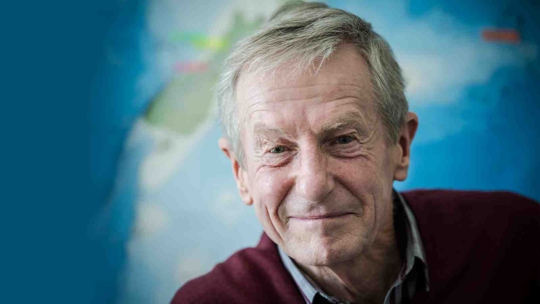Understanding what's under the ocean
Understanding what's under the ocean
As a self-professed terrible sailor, Professor Lionel Carter says it’s ironic that he’s spent a large part of his career at sea.
Victorious Autumn 2016

"I’ve spent a total of two and a half years of my life bobbing around on the ocean—the very thought makes me feel queasy!” he says. “But it’s all for the greater good and overall it has been a lot of fun.”
Lionel is a world-renowned ocean scientist based at Victoria’s Antarctic Research Centre and has specialised in geological and oceanic processes. He joined Victoria in 2006 and his many achievements demonstrate a true commitment to understanding New Zealand’s oceans.
In the early 1970s, Lionel helped map out the proposed boundary of New Zealand’s Economic Exclusion Zone (EEZ) and determined what lay within it. His reports were used to establish the EEZ, which extends 200 nautical miles (370 kilometres) out from the shoreline. At 4 million square kilometres, New Zealand’s EEZ is one of the largest in the world and accounts for more than 90 percent of our territory.
“As a nation, New Zealand is responsible for a huge area,” explains Lionel. “Including our EEZ and stewardship role under the Antarctic Treaty System, we are responsible for a territory that literally goes from the sub-tropics to the South Pole.”
Lionel is also a marine advisor for the International Cable Protection Committee, which works to protect submarine fibreoptic cables across the globe from natural hazards. “These cables are essential: they convey almost all of the world’s internet data, commercial and voice communications, which clearly have enormous social and economic importance. We are totally reliant on this network of cables, so it’s critical to protect them from human-related and natural hazards.”
The achievement Lionel is most proud of is finding the path of the Pacific Deep Western Boundary ocean current, and its impact on New Zealand’s submarine landscape. He led a team that discovered that sediment from the Southern Alps is being constantly ‘recycled’; material eroded from mountains travels down rivers into the ocean and is transported up to 4,500 kilometres by this deep western boundary current to northern New Zealand. There, it gets caught up in the tectonic plate boundary and is dragged into the Earth’s crust, where the sediment is heated and returned to the surface via volcanic eruptions.
Last year, Lionel’s contribution to science was recognised with the presentation of the 2015 Hutton Medal, which is awarded annually by the Royal Society of New Zealand for outstanding research in earth, plant and animal sciences. He was made a fellow of the Royal Society in 2003 and received the Marsden Medal for outstanding service to science in 2012.
“That sort of recognition really comes down to the remarkable group of people I’ve worked with over the years,” says Lionel. “The problems in environmental science are so large you need all kinds of scientists—physicists, chemists, biologists and geoscientists—to get as much knowledge as possible about how the environment works. That’s why Victoria is such a great place to conduct this sort of research.”
Never one to sit still, Lionel is now turning his attention to finding out how New Zealand has responded to recent climate change by examining detailed ice and sediment deposits from the Ross Ice Shelf to New Zealand, again “with a little help from my friends”.
“I’ve been always been interested in how stuff works, and I’m lucky to be able to devote my career to studying the most fundamental, ‘bread and butter’ science,” he explains. “I want to know how the planet we call home functions.”
Contact:
Phone:
Email:
